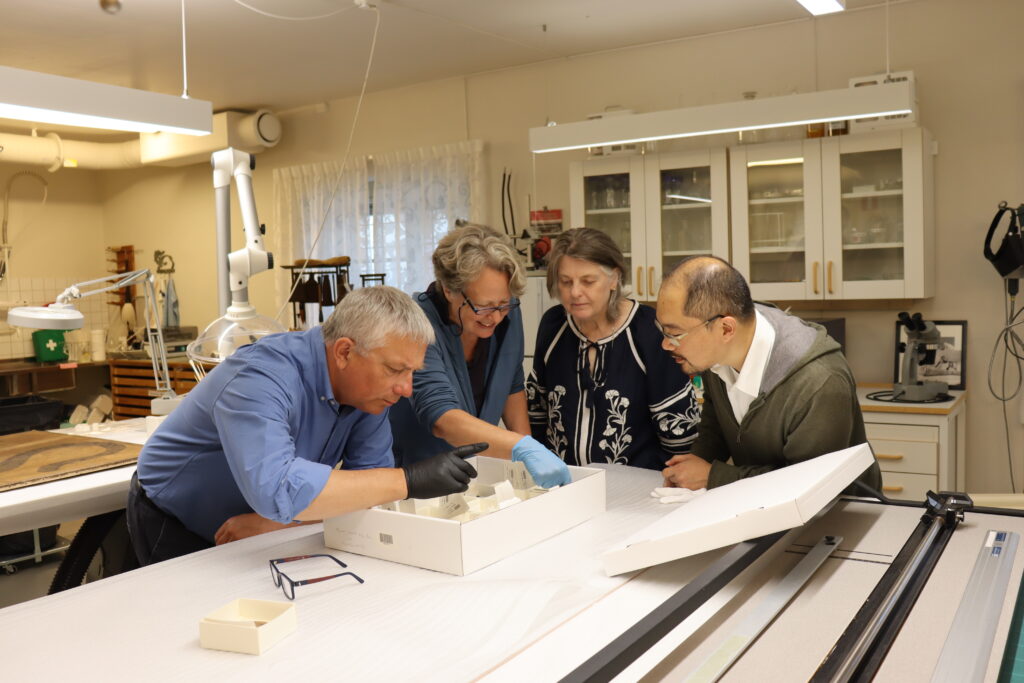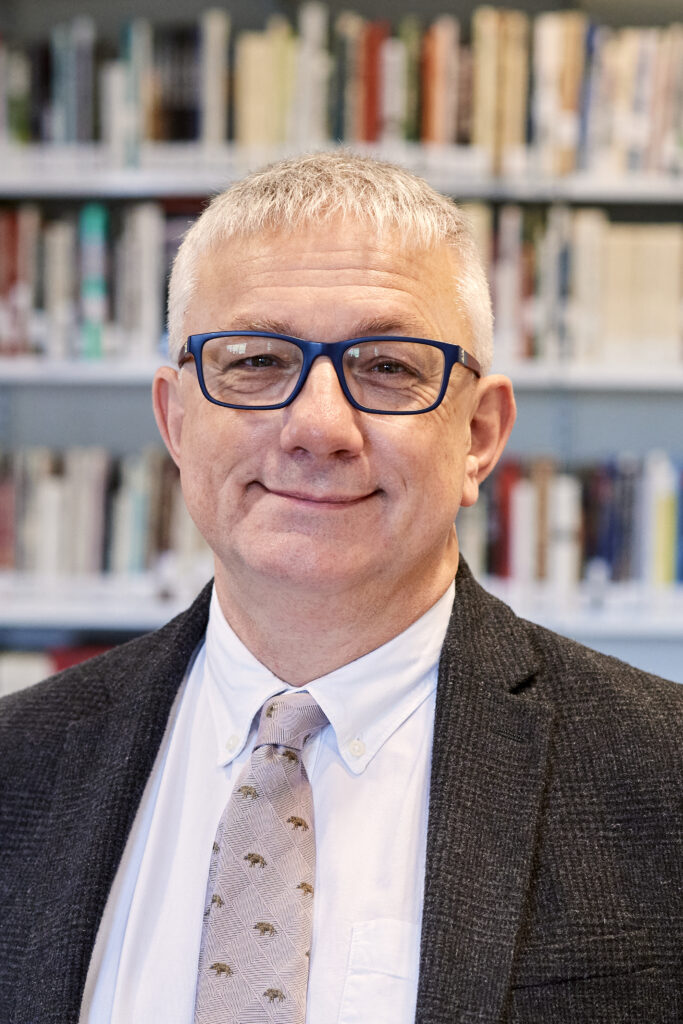2022.11.17
DIALOGUEProviding Young Europeans with Opportunities for Interdisciplinary Japanese Studies, the Sainsbury Institute for the Study of Japanese Arts and Cultures

Prof. Simon Kaner (far left) examining Japanese and Chinese historical artifacts with fellow scholars at the Museum of Far Eastern Antiquities in Stockholm as part of SISJAC’s Nara to Norwich initiative. Photo by Naomi Hughes-White
The Japan Foundation has a long-standing relationship with Japanese studies in Europe. Let’s take a look back at the history of this relationship and examine recent trends in Japanese studies in Europe. The U.K.-based Sainsbury Institute for the Study of Japanese Arts and Cultures is a great place to begin.
The study of Japan in Europe has a long history, with some saying that its origins can be traced back to the records of Christian missionaries who came to Japan in the 16th century. Various European institutions of higher education have independently developed Japanese studies programs. This includes the establishment of the Department of Japanese Studies at Leiden University in the Netherlands in 1855.
In 1973, a conference of leading European researchers of Japanese studies was held at Oxford University to establish the European Association for Japanese Studies (EAJS). There was a need to promote mutual collaboration among researchers from different countries and to revitalize Japanese studies as a field of study with diverse perspectives. In 1975, the Japan Foundation (JF) and EAJS co-organized the first EAJS International Conference at the Japan Cultural Institute in Rome. The conference has been held every three years since, rotating among each member country. The EAJS has played an irreplaceable role in bringing together researchers of Japanese studies from around the world, including Japan, to share professional achievements and experiences and to foster a new generation of young researchers. Membership has now expanded to about 50 countries.

In 1973, leading researchers into Japanese studies from across Europe gathered for the first time at Oxford University in the U.K. to establish the European Association for Japanese Studies (EAJS).
In 1974, the British Association for Japanese Studies (BAJS) was established to promote Japanese Studies in the U.K. JF has long supported their activities by helping to organize conferences and co-sponsoring workshops to foster the next generation of Japanese Studies researchers. The professional connections made through the activities of EAJS and BAJS have led to such benefits as increased exchange of information among members and mutual enhancement of each other’s research.
Enabling Interaction with the Ancient World through Cutting-Edge Technology
Prof. Simon Kaner of the Sainsbury Institute for the Study of Japanese Arts and Cultures (SISJAC) in the U.K. is working to foster and strengthen the network of researchers in Japanese studies in Europe and beyond, including through the activities of the EAJS. SISJAC was established in 1999 to promote knowledge and understanding of Japanese arts and culture, and is affiliated with the University of East Anglia (UEA). SISJAC operates across a wide range of research fields and maintains a unique position as a major center for Japanese arts and cultural studies in the U.K. JF has provided support in a variety of ways, including subsidizing international conferences and workshops held by SISJAC, and co-organizing lectures, such as one on the Jomon period and Jomon pottery during the Flame Pots exhibition at the British Museum in London in 2012. We spoke with Prof. Kaner, who also serves as Director of the Centre for Japanese Studies at UEA, about his own research and trends in Japanese studies in Europe.

Prof. Simon Kaner, Executive Director of the Sainsbury Institute of Japanese Arts and Cultures in Norwich, the county town of Norfolk in eastern England. Received his PhD from the University of Cambridge. Specializes in Japanese prehistoric archaeology. Prof. Kaner is also the Head of the Centre for Archaeology and Heritage at SISJAC and the Director of the Centre for Japanese Studies at the University of East Anglia. Photo by Andi Sapey
Prof. Kaner specializes in the archaeology of prehistoric Japan. During his college years, he visited Japan for four weeks with his professor at the University of Cambridge, Gina Lee Barnes, to search for ancient paddy fields and excavate ancient tombs. He met a renowned expert on archaeology, KONDO Yoshiro, who was Professor of Archaeology at Okayama University. Later, he decided to focus his research on prehistoric Japan, and studied at Kyoto University.
Prof. Kaner describes his fascination with archaeology as follows: “Archaeology is a discipline that gives everyone access to human diversity and the depth and breadth of human history.” For example, there are “stone circles” in both Japan and the U.K. “Oyu Kanjo Resseki (Oyu Stone Circles),” a World Heritage Site in Kazuno City, Akita Prefecture, is an archaeological site dating back to the late Jomon Period (about 4,000 years ago). The famous stone circle at Stonehenge in the U.K. is said to have been created at a similar time, between 2500 B.C. and 2000 B.C. In conjunction with the World Heritage registration of the “Jomon Prehistoric Sites in Northern Japan” that include the Oyu Stone Circles, Prof. Kaner planned the exhibition “Circles of Stone: Stonehenge and Prehistoric Japan” at the Stonehenge Visitor Centre (originally scheduled for 2020 but postponed to September 2022 due to the COVID-19 pandemic).
In conjunction with the exhibition, Prof. Kaner photographed stone circles in Japan with a drone and converted the data into 3D imagery so it could be viewed from 360 degrees in a virtual space. “Students are fascinated by the process of using this kind of state-of-the-art technology. Using such technologies as virtual reality (VR) and social media that they’re already familiar with, the younger generation can interact with prehistoric artifacts in their own way. Why did prehistoric people make these things? What kind of lives did they lead? Archaeology allows us to access these stories that get to the core of humanity in exciting new ways.”
SISJAC Relishes New Challenges
In 2020, SISJAC launched a new Master’s program called “Interdisciplinary Japanese Studies” based at UEA. With regard to the program, Prof. Kaner further explained that “The program is designed to study many things about Japan across a wide variety of fields. Students can study multiple aspects, including art history, modern history, archaeology, literature, and political science. Students who have never studied Japanese before, or who are unsure whether to continue Japanese studies in their future careers, may gain significant insight into their future career paths by being exposed to an interdisciplinary approach. An example is one of our students who excelled on our MA after studying psychology at Oxford University, decided she wanted to know much more about Japan and won a Japanese government scholarship to study at Ritsumeikan University in Kyoto.”

Prof. Kaner speaking in the summer of 2019 at the “Ishibashi Foundation Summer Fellowship,” organized by SISJAC and UEA and sponsored by the Ishibashi Foundation. Photo: ©Sainsbury Institute for the Study of Japanese Arts and Cultures
The areas of study afforded by SISJAC are truly diverse, ranging from archaeology to crafts, fine arts, manga and animation, and digital technology. Prof. Kaner added, “We want to provide the best higher education in all aspects to those who aspire to Japanese studies. Here you can conduct research on Japan from prehistoric times to the present day, from Hokkaido to Okinawa.”
It is a big decision to devote one’s life to Japanese studies, but what kind of topics do young European researchers tend to choose? “Japanese arts and culture are of course very popular in their own right, but recently, students are discovering new themes, such as how Japan has contributed to the wider world in terms of arts and culture. SISJAC offers a wide range of research areas and an interdisciplinary approach. There are many other specialized institutes that are experts in their fields of traditional Japanese studies, but SISJAC likes to take on the challenge of new areas of research that no one else is working on.”
Regarding SISJAC’s popular Japanese Art and Cultural Resources research program, Prof. Kaner describes it this way: “With JF’s support, we were able to increase our staff in 2011. We are grateful for their cooperation in starting a similar program for contemporary Japanese literature at UEA in 2020. Now, we can confidently recommend both of these programs to students at various universities who are engaged in Japanese studies, and I think they are making a significant contribution to supporting research activities by students and expanding the network of researchers.”
JF, together with SISJAC and other similar research institutes and academic organizations in Europe, will continue to support young scholars develop their interest in Japanese Studies.
【Related page】
The Development of Ohira School into the Beijing Center for Japanese Studies, and into a Platform of Japanese Studies Open to the World
